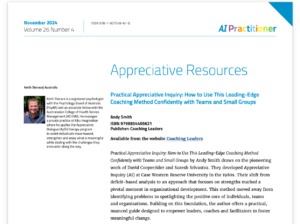How the Experience Cube Works in Coaching (4

[ad_1]

This article follows on from previous articles considering the other quadrants of the Experience Cube: Observations, Thoughts, and Emotions – so you might want to read those first.
The fourth quadrant of the ‘Experience Cube’, as described in Gervase Bushe’s excellent book Clear Leadership: Sustaining Real Collaboration and Partnership at Work, is about what we want to happen.
In Bushe’s book the focus is on how leaders and managers communicate what they want their colleagues and subordinates to do about a given situation. In one-to-one coaching, this quadrant is about helping our coaching clients get clearer about what they want, and consequently, what they expect of themselves.
“What do you want?” vs “What do you want to get away from?”
Clarification could be as simple as asking the question “What do you want?”
You could narrow the focus of this question a little by asking “What do you want to happen?”, or even “What would you want to happen in an ideal world?”
This question gets them to think about what they really want, without limiting their aspirations to what they think is ‘realistic’ or hemming themselves in with constraints (which might exist in the real world, but may nevertheless be possible for them to find ways round or through, or that might just be products of their own belief systems, a kind of ‘learned helplessness’ deriving from their past experiences).
You could also ask “What do you want to do?”, helping them to clarify their preferences and the choices they see as open to them. If the client is not sure, you could help them explore their choices by asking “What could you do?”
Often the client may not be sure what they want, beyond wanting their presenting problem to stop, go away, and not recur. Their motivation, as far as they are aware of it, is ‘away-from’ rather than ‘towards’. While this kind of motivation can be useful as a kick-start to action, it doesn’t work as a guide to what to do in the future, because as soon as you get far enough away from what you want to escape, motivation drains away.
In this situation we can ask questions that help the client to clarify an idea of where they want to get to, as opposed to just ‘away’.
“What do you want instead of this?”
“How will you know when the problem is solved?”
“When the problem is solved completely, what will that look like?”
What Values Make the Desired Future Desirable?
Once the client has some idea of a solution or solutions that they can feel attracted towards, you can help to clarify the values that will motivate them to get there by asking:
“What’s important to you about <the solution>?”
As there will be more than one value motivating them, you can follow up with “What else is important? And what else is important about that?”
This is worth doing, not least because the values that are most important to the client may not be the ones that are ‘front of mind’ for them, so the first answer they give may not be their primary motivation. How will you know when to stop asking “And what else is important about that?”
Even when they think they’ve said everything, I often push it a little further by saying something like, “OK, you think there aren’t any more… so what else is important about that?”
Very often this will surface one or two more values that are important to the client, but were below the surface of their awareness until they thought about it. But if it seems like I am about to lose rapport with the client, I will definitely stop asking!
Looking Beyond the Desired Future
You could assist the client in deepening and enriching their future vision, by stretching the time frame a little further into the future and asking “And when you have <the desired solution>, what will that do for you?” or even (taking a leaf out of Connirae and Tamara Andreas’ book Core Transformation: Reaching the Wellspring Within (highly recommended for anyone interested in therapy or personal development), “What will that get you that’s even more important than that?”
Focusing on the beneficial consequences of their desired solution will further strengthen their motivation to get there.
In Part 2 of this article, we’ll look at how to make the desired future feel achievable, and how the client can become who they need to be to get there.
I’m starting a new Practical Appreciative Inquiry facilitator training soon. If you like my materials and the way I approach things, this is pretty much the only training I’m doing these days – and it gives you a great method for coaching teams and small groups!
“Andy’s class on practical appreciative inquiry was exactly what I was looking for. His content is rich and excellent and speaks right to the hearts and minds of facilitators in the business world and community. I highly recommend this course to anyone interested in working with leaders on this brilliant model” – Brenda Abdilla, Executive Coach & Author | Speaker & Facilitator| Assessments Expert | Founder of The Entourage Leadership Group for Women | Chapter Chair Denver WPO (see this testimonial plus many others from course graduates in the ‘Recommendations’ section of my LinkedIn profile)
[ad_2]




